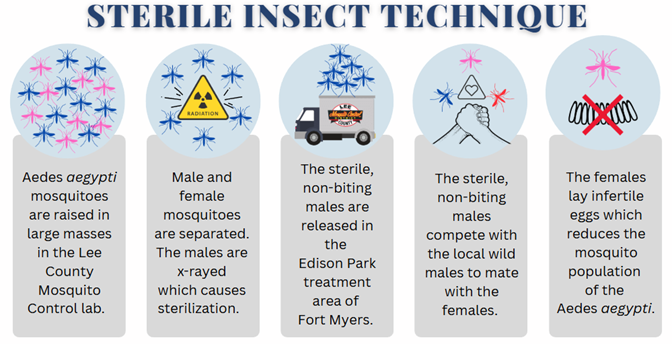Sterile Insect Technique (SIT) FAQs
What is SIT?
The sterile insect technique (SIT) is a method that is used to reduce insect populations. It involves releasing lab-reared sterilized insects to mate with the wild population to reduce the targeted species.
Has SIT been used before?
Yes! SIT is not new technology. In fact, its first use in the United States occurred on Sanibel Island in 1951 to eliminate the screwworm fly. Recently, sterile screwworm flies were released to successfully control a localized outbreak in the Florida Keys. Currently, around the world, SIT is used to control various agricultural pests, including the Mediterranean fruit fly, along with medically important insects, such as the Tsetse fly which spread sleeping sickness parasites to cattle and humans in Africa.
How does SIT work at LCMCD?
At LCMCD, we lab-rear Aedes aegypti mosquitoes which are commonly found in urban neighborhoods such as yours. Once at the pupae life stage, we X-ray the males which causes sterilization. These sterile adult male mosquitoes are then released into the environment to mate with wild females. The eggs laid by female mosquitoes will not hatch which will reduce the mosquito population. For population reduction LCMCD releases sterile male mosquitoes which do not bite. Only the female mosquito bites!
Is there any genetic modification with this method of control?
NO! Sterilization is achieved through X-ray irradiation and requires no genetic manipulation of the organism. The X-rays used are the same as those used in medical practices.
Which mosquito does LCMCD target with SIT?
Aedes aegypti, an exotic invasive mosquito, is targeted. This species of mosquito can carry many viruses, including yellow fever, dengue, chikungunya, and Zika. It is an urban mosquito which means it breeds around homes and prefers to feed on humans. They are difficult to control by conventional methods (insecticide application and source reduction) due to their use of containers and daytime biting habits.
Will any female mosquitoes be released?
Male mosquitoes are separated out from females prior to their release. However, an exceedingly small number of females may be released with males. These females are no different from the local population except that they are sterile. There will not be an overall increase in biting mosquitoes due to releases.
What should I expect in my neighborhood after a release?
You might experience an increased number of mosquitoes right after a release. While it may be an annoyance (mosquitoes are pests!), LCMCD releases male mosquitoes which do not bite.
Where do you plan to release sterile mosquitoes?
Sterile male Ae. aegypti will be released near Centennial Park (downtown) to south of Fort Myers High School. Neighborhoods where releases are planned include West 1st Street, Altamont Manor, Edison Park, Poinciana Park, Valencia Terrace, and Sunset Park. This area is subject to change.
Click HERE to see the current treatment area.
Why is LCMCD releasing sterile male Ae. aegypti in this area?
While Ae. aegypti can be found through much of Lee County, this area was selected for releases due to the known abundance of the population. Prior to selection of this area, LCMCD trapped five candidate sites that also had known populations of Ae. aegypti. This area had the most Ae. aegypti present and the most even distribution of the population, indicating that additional mosquito control measures were needed to help suppress these mosquitoes.
How often are the scheduled releases?
Generally, releases will occur twice per week. We plan on releasing Tuesdays and Fridays, but this schedule may change based on weather or other complicating factors.
How long will the releases continue?
This is ongoing, rather than an immediate mosquito control method. We are currently not able to set an end date. That being said, we may adjust release amounts and frequency depending on the feedback we get from our traps.
How can I reduce the number of mosquitoes at my house?
Source reduction is the key! Aedes aegypti need standing water in containers to breed. These can be natural (ex. bromeliads) or man-made (ex. flowerpots, clogged gutters, rain barrels, etc.), Ae. aegypti aren’t picky. Because sterile males are attracted to areas where female Ae. aegypti are present, the best way to make sure that they don’t stay around is to limit breeding sites. Please consider ways that you can help us help you.
How are you monitoring the effectiveness of the SIT program?
The SIT program follows rigorous documentation for quality and effectiveness. Released mosquitoes are dusted with fluorescent powder. Traps for adult mosquitoes and for eggs are strategically mapped and placed around the neighborhood. The mosquitoes and eggs collected in the traps are analyzed and recorded which helps us determine our impact on the population of Ae. aegypti.
What are the results so far?
Great! We have already seen significant impacts and a reduction in the population of Ae. aegypti in the areas where we have been releasing. We are expecting an even greater reduction in the population this year.
Who do I contact if I have any questions?
You may email sterileinsect@lcmcd.org with questions or concerns.

